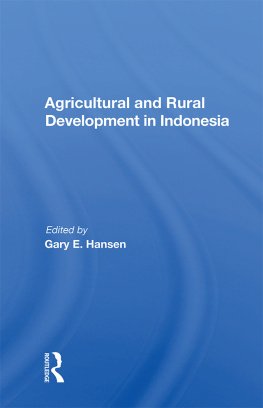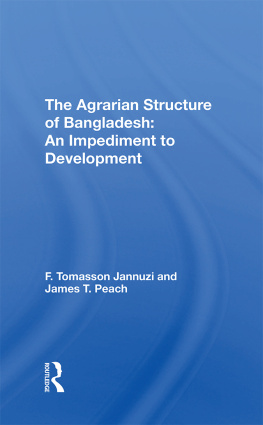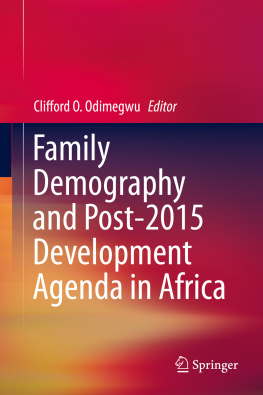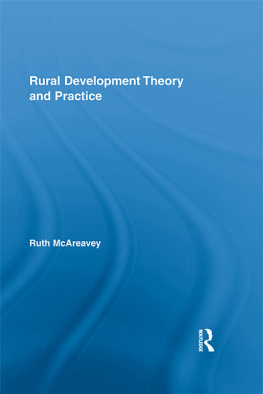Rural Settlement Structure and African Development
First published 1998 by Westview Press
Published 2019 by Routledge
52 Vanderbilt Avenue, New York, NY 10017
2 Park Square, Milton Park, Abingdon, Oxon OX14 4RN
Routledge is an imprint of the Taylor & Francis Group, an informa business
Copyright 1998 by Taylor & Francis
All rights reserved. No part of this book may be reprinted or reproduced or utilised in any form or by any electronic, mechanical, or other means, now known or hereafter invented, including photocopying and recording, or in any information storage or retrieval system, without permission in writing from the publishers.
Notice:
Product or corporate names may be trademarks or registered trademarks, and are used only for identification and explanation without intent to infringe
Library of Congress Cataloging-in-Publication Data
Rural settlement structure and African development / edited by Marilyn
Silberfein.
p. cm.
Includes bibliographical references and index.
1. Land settlementAfrica. 2. Rural developmentAfrica.
I. Silberfein, Marilyn.
HD966.R87 1998
333.36dc21
97-30490
CIP
ISBN 13: 978-0-367-28639-2 (hbk)
To the Memories of
My father, Ben Silberfein and my advisor, David Sopher, whose work inspired the kinds of studies found in this volume
States are not formed by elections. They are formed by geography, war, settlement patterns, and the literate bourgeoisies."
Robert E. Kaplan, Democracys Trap,
New York Times, Dec. 23, 1995, p.E9.
Contents
PART ONE
Background to the Study of Settlement
, Marilyn Silberfein
, David Grossman and David Siddle
PART TWO
The Historical Perspective
, James L. Newman
, Marilyn Silberfein
PART THREE
The Evolution of Settlement Types: Some Case Studies
, Glenn Davis Stone
, R.M.K. Silitshena
, Robert E. Ford
, Robert E. Ford
PART FOUR
Rural Development Programs: The Role of Settlement Structure
, Edward C. Green and Raymond T. Isely
, Asmarom Legesse
PART FIVE
National Settlement Strategies
, Lovemore Zinyama
, Richard J. Massaro
PART SIX
Conclusions and Implications for the Future
, Marilyn Silberfein
Figures and Tables
Figures*
Note
* These maps were prepared by Gerry Krieg in the Temple University Cartography Lab. The lab is directed by Mark Mattson.
Tables
This volume is the result of a group of researchers applying their insights and experience to a common theme. All the authors are concerned with rural development in Africa and all have focused on the connection between the development process and the arrangement of people and their built environment in rural space. Both anthropologists and geographers have contributed to the dialogue on this subject and representatives of the two disciplines are included in this volume.
The members of this group have never all been in the same place at the same time, and so have utilized various electronic modes of communication to link their locations around the world. Two conferences were organized, however, among a subset of the whole, in order to generate a group discussion. One of these meetings was a symposium on African rural development held at Temple University while a second was organized at the African Studies Association Meetings in Toronto. Both opportunities helped raise issues that found their way into individual chapters. The audience in each case further stimulated our thinking.
All of the authors have been patient and persistent as the editor tried to weave these individual pieces into a coherent whole. So little has been written on our subject that everyone was highly motivated to add this volume and to the general discussion on rural development. We remain hopeful about the long-term viability of African rural areas, in spite of a litany of problems that have beset the continent in recent years.
The cartography lab at the Department of Geography and Urban Studies, Temple University, under the direction of Mark Mattson, played an important role in finalizing this manuscript. Initially, several graduate students were involved in map preparation, but the lead role was taken by Gerry Krieg who has continued his involvement with the project.
None of the chapters could have been written, however, were it not for the African academics, students, bureaucrats, farmers, and others who assisted the research effort of each author. We hope that many of them will get to see this volume and that they will find it to be both stimulating and useful.
Part One
Background to the Study of Settlement
1
Introduction
Marilyn Silberfein
This overview of rural settlement in Africa was first conceived to fill a gap in the literature and respond to development specialists who had complained that there were no sources for assessing the relative importance of settlement patterns. Their key question can be stated as follows: does settlement, or the arrangement of people and their built environment in rural space, have to be taken into account in evaluating development potential or in designing new programs, particularly those based on local participation? This book comes to grips with this issue but it has evolved further, focusing on such related themes as the evolution of settlement types and the efficacy of settlement schemes. It has also come to include many, if not most, of the geographers and anthropologists writing in English who have made the relationship of settlement and development one of their strong research interests.
The Nature of Settlements
Rural settlements are concerned principally, though not exclusively, with primary activities, particularly food production. They contrast with urban settlements in which the creation and/or distribution of goods and services become dominant. The interface of these two realms can be sharp or blurred. In some cases, settlements may defy categorization; in others, rural places gradually expand their range of activities and become increasingly urban over time, although they may continue to function socially as villages. The contact zone of rural and urban is an area of research in its own right but in this study it is a secondary theme, referred to in several of the chapters and at greater length in the conclusion.
Rural settlements are also landscape features. They include structures designed primarily to provide for shelter and storage as well as facilities for food preparation and the ancillary activities of the household or the larger community. The arrangement of all of these settlement components reflects the needs of the production system, but it also expresses cultural values. Such attributes of settlements as the orientation of buildings or their exterior design and shape are not necessarily functional; rather they may demonstrate aesthetic preferences or aspects of the local cosmology. There is always a symbolic aspect to settlement structure that is reflected in the built environment as well as in the existence of sacred spaces that are set apart from those areas reserved for shelter and various aspects of the production system.
There are two other aspects of rural settlement that need to be addressed:









